yogabuch / asanas / purvottanasana
Contents
- 1 purvottanasana
- 2 Variants
- 2.1 1a: Legs bent (feet up), arms stretched, hands pointing forward
- 2.2 1b: Legs bent (feet on the floor), arms stretched, hands pointing backwards
- 2.3 1a eka pada: legs bent (feet up), arms stretched, hands pointing forward, one leg raised
- 2.4 1b eka pada: legs bent (feet up), arms stretched, hands pointing backwards, one leg raised
- 2.5 2a: Legs stretched, arms stretched, hands pointing forwards
- 2.6 2b: Legs stretched, arms stretched, hands pointing backwards
- 2.7 2a eka pada: legs stretched, arms stretched, hands pointing forward, one leg raised
- 2.8 2b eka pada: legs stretched, arms stretched, hands pointing backwards, one leg raised
- 2.9 3: Legs bent (feet planted), arms bent (forearms planted)
- 2.10 3 eka pada: legs bent (feet planted), arms bent (forearms planted), one leg raised
- 2.11 4: Legs stretched, arms bent (forearms raised)
- 2.12 4 eka pada: legs stretched, arms bent (forearms resting on the floor), one leg raised
- 2.13 Belt around the thighs
- 2.14 Wrists on patches
- 2.15 Fixing the feet
- 2.16 (P) Stretching the raised leg
- 2.17 (P) Lifting the pelvis with a belt
- 2.18 (P) Raise the back between the shoulder blades
- 2.19 (P) Keep the knees together
- 2.20 (P) Correct foot posture
purvottanasana
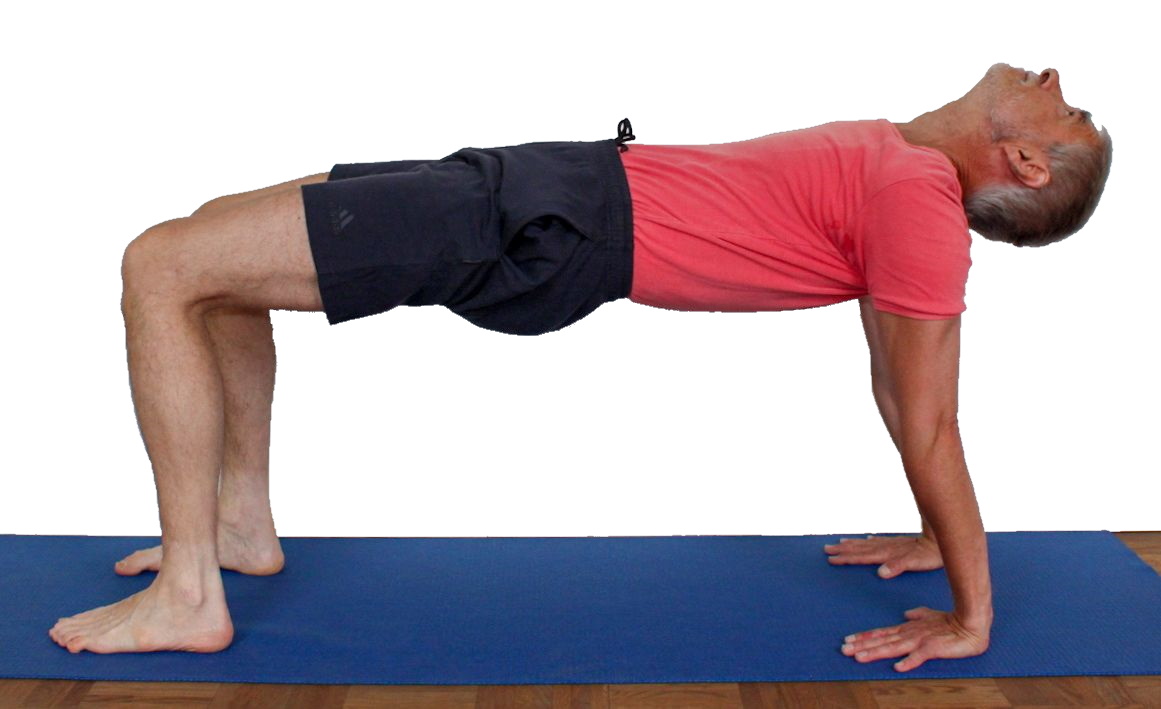
 instructions and details with working links as PDF for download/print
instructions and details with working links as PDF for download/print
Feedback: We would love to hear what you think about this description, give us feedback at:
postmeister@yogabook.org
last update: 12/30/2018
Name: purvottanasana
Level: A
- Classification: A
- Contraindication
- Effects of
- Preparation
- follow-up
- derived asanas
- similar asanas
- diagnostics
- Instruction
- details
- Variants
Classification
classic: posture
Contraindication
Effects
- (202) Strengthening of the neck / cervical spine for flexion
when the head is raised - (352) Strengthening for palmar flexion in the wrist
- (722) Strengthening of the hamstrings
- (827) Strengthening the hamstrings as internal rotators of the knee joint
- (602) Strengthening the back extensors
- (727) Strengthening the short hip extensors (especially the gluteus maximus)
- (712) Strengthening the hip flexors
All variations with one leg raised - (226) Shoulder blade: stretching for retraction
- (311) Biceps: stretching
all variations with outstretched arms - (246) Shoulder joint: stretch for retroversion
- (341) Stretch for dorsiflexion in the wrist
- (511) Stretching the pectoralis major
all variations - (711) Stretching the hip flexor
- (206) Neck/spine stretch in the direction of reclination
Preparation
Follow-up
derived asanas:
similar asanas:
Diagnostics (No.)
Variants:
1a: Legs bent (feet up), arms stretched, hands pointing forward
1b: Legs bent (feet up), arms stretched, hands pointing backwards
1a eka pada: legs bent (feet up), arms straight, hands pointing forward, one leg raised
1b eka pada: legs bent (feet up), arms straight, hands pointing backwards, one leg raised
2a: Legs stretched, arms stretched, hands pointing forwards
2b: Legs stretched, arms stretched, hands pointing backwards
2a eka pada: legs stretched, arms stretched, hands pointing forwards, one leg raised
2b eka pada: legs stretched, arms stretched, hands pointing backwards, one leg raised
3: Legs bent (feet planted), arms bent (forearms planted)
3 eka pada: legs bent (feet planted), arms bent (forearms planted), one leg raised
4: Legs stretched, arms bent (forearms raised)
4 eka pada: legs stretched, arms bent (forearms placed on the floor), one leg raised
(P) Raise back between shoulder blades
Instructions
- As there are a number of useful variations of purvottanasana, I will describe them systematically below. The variations differ mainly in three parameters:
- Legs bent or stretched, i.e. feet or only heels raisedArms bent or stretched, i.e. only hands (pointing forwards or backwards) or entire forearms placed on the floorBoth legs on the floor or one leg extended and raised
- Feet up with bent legs, hands upFeet up with bent legs, hands up, one leg raisedFeet up with bent legs, forearms upFeet planted with legs bent, forearms planted, one leg raisedHeels up with legs straight, hands upHeels on with legs straight, hands on, one leg raisedHeels up with legs straight, forearms upHeels on with legs straight, forearms on, one leg raised
This does not apply if the biceps is relatively less mobile than the deltoid. - In all variations, whether with straight or bent arms, the shoulder blades are largely retracted, so the upper body does not „sink“ between the arms.
Details
- Information on dealing with cubitus valgus in all variants with straight arms can be found in movement physiology under axial misalignment.
Variants
1a: Legs bent (feet up), arms stretched, hands pointing forward
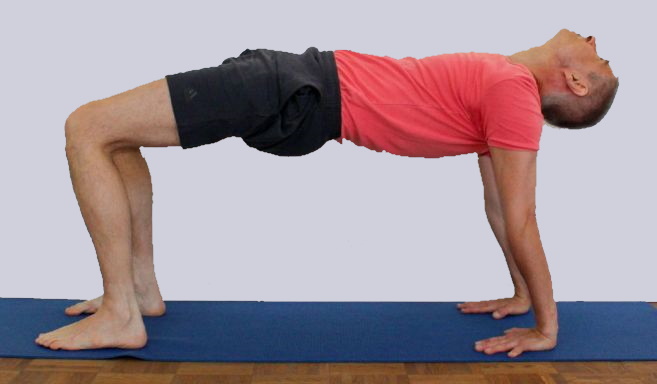
Instructions
- Sit in dandasana.
- Place the feet parallel and hip-width apart near the pelvis, place the hands shoulder-width apart behind you with the arms stretched out and the extensor tendons of the middle fingers on the back of the hands pointing forwards.
- Raise the pelvis to the maximum and use the strength of the pomucous muscles to achieve maximum extension in the hip joints.
- If necessary, adjust the distance between your feet and hands so that your lower legs and arms are vertical.
- Lower your head as far as possible into reclination and raise your upper body and pelvis again as far as possible.
Details
- The position of the head naturally influences how much the upper body can be raised. Following the principle of a seesaw, the raised head will make it more difficult to raise the upper body and the lowered head will make it easier. Corresponding restrictions in flexibility in the neck and throat area further intensify this effect. If there is no movement in the neck, the head should sink passively to the floor as far as possible under its own weight. One advantage of these postures is that no muscular strength is required to recline the head; gravity alone can achieve this excellently due to the roughly horizontal thoracic spine. In comparison, depending on flexibility, for example in a head-up dog p ose, much more muscle strength is required to get the head into reclination, which can lead to corresponding cramps and has far less of a stretching effect on the throat area. The opportunity offered by purvottanasana should be used if possible.
- The flexibility of the shoulders in the direction of retroversion is one of the two most important limiting factors (the other is the ability to extend the hip joints) in this pose. In hardly any other posture are the arms so far into retroversion. Ideally, the arms are vertical and the upper body is horizontal or raised above this in the pelvic region, i.e. the hip joints are higher than the shoulders, which corresponds to at least 90° retroversion. In practice, however, the flexibility of the anterior deltoids (pars clavicularis), the pectoralis and also the biceps significantly restrict the angle between the arms and upper body. Due to its function as a flexor of the elbow joint and frontal adductor, the biarticular biceps in both heads is in exactly the opposite position in both joints and is therefore maximally stretched. It is usually felt less in the two origins than just before its attachment area on the radius. There is hardly a better posture for stretching the biceps, whereby the rotation of the hand and therefore the forearm plays a role here: hands pointing backwards allow greater exorotation of the upper arm than those pointing forwards, which in turn has an effect on stretching the front part of the deltoid and the biceps. In the case of single-joint muscles such as the pectoralis and deltoid, the stretching effect of this posture is evident as they perform the opposite movements. This posture is also optimal for the pars clavicularis of the deltoideus. Of course, the position of the hand plays a role: if it points forwards towards the feet, the forearm is in (almost maximum) pronation and points backwards in (also almost maximum) supination. Supination of the forearm facilitates exorotation of the upper arm, while pronation suppresses it slightly. Accordingly, the two variations differ in their effect on the shoulder muscles. There is a further difference in the biceps, as this attaches to the radius and acts as a supinator over a wider angle range. With the forearm in pronation, i.e. the hand pointing forwards, the stretching effect is therefore greater.
- The other important limitation is the flexibility of the hip flexors, which limit the extension in the hip joints or force a remaining flexion. Of course, care must be taken to push the pelvis into extension with all the strength of the hip joint extensors, if only for the well-being of the lumbar spine region. Unlike in many backbends, however, the knee joints are bent quite far here at 90° and push the pelvis upwards into extension of the hip joints against a large partial body weight at nearly 100% against gravity, which results in a certain tendency to cramp in the biarticular hamstrings, which some people feel quite clearly in this posture. The hamstrings is not far from its minimum sarcomere length and thus active insufficiency. If the tendency to cramp occurs, a greater distance between the feet and the hands (and therefore a greater angle in the knee joint) and a focus on the work of the quadriceps can help to push the pelvis further upwards by stretching the knee joint. In variants with both knee joints bent and feet on the floor, the tendency to cramp is usually still moderate, but occurs from time to time; if one leg is raised, it increases significantly because the necessary work of the hamstrings increases considerably. After all, two legs no longer lift a partial body weight but only one and the other, which previously lifted with it, must now also be lifted. Appropriate stretching preparations for the hip flexors can make the posture much easier. In the variants with the leg extended on the floor, it is significantly reduced because the hamstrings are stretched in the knee joint and therefore in larger sarcomer length.
- Due to the intensive work of the gluteus maximus and the pull of the hip flexors, the thighs in the hip joint have a tendency to exorotate and abduct, which must be countered with appropriate force application of the adductors (alternatively a supporter or a belt). This tendency can spread to the feet and cause them to twist, especially because within the vigorously working hamstrings, the external rotator of knee joint, the biceps is usually stronger than the internally rotating inner muscles of the ischiocrural group. In contrast to setu bandha sarvangasana, however, the force of the quadriceps used to extend the knee joint is lower, as otherwise the upper body would be pushed too far away from the feet, which explains why the tendency to develop discomfort in the outer knee is significantly lower here than in setu bandha sarvangasana.
There, the shoulders rest heavily on the floor on a mat that usually provides good grip, while in purvottanasana the frontalabductors of the shoulder joint have to hold the upper body in position with little force in a long sarcomere length. - Similar to halasana, but far less pronounced, the spine tends to bend induced from above(cranial) and below(caudal), but here from both extremities, arm and leg, due to the flexibility restrictions of the joints in which they are suspended(shoulder and hip joint) and the resulting forces acting on the upper body, which force the back into flexion. This requires significant exertion of the autochthonous back muscles. However, it is much easier to straighten the back here than in halasana.
- The shoulder blades are in depression (moved towards the pelvis) and retraction (moved inwards towards the spine ). The upper body lifts up in the shoulder area between the arms.
- If the elbow joints hyperextend, it is again advisable to use the arm biceps in order to control the angle in the elbow joint at will to make the force ratios in the elbow joint more favorable and to relieve the dorsal/ulnar area. In the case of very immobile biceps, however, the question of hyperextension does not arise because exact stretching is not possible and the path to it is characterised by intense stretching sensation.
- Sometimes the dorsal wrist becomes noticeable with discomfort. As always, the first measure is to work more vigorously with the palmar flexors of the wrist so that the muscles bear more weight and the non-muscular structures are relieved. Also make sure that the distance between the hands and feet is not too small, as this can make the angle in the wrist less favorable; if necessary, increase it slightly.
- Keep the knees hip-width apart to strengthen the adductors and prevent the feet from turning outwards. To do this, press both the heel and the ball of the foot firmly onto the floor. Any relief here would cause the foot and lower leg to turn out according to the rotational forces of the hamstrings.
- Normally, the lower legs and arms should be vertical. If the angle of dorsiflexion of around 90° is difficult for the wrists and
- pain occurs in the dorsal wrist area or
- there is excessive stretching sensation in the finger flexors or
- if excessive stretching is felt in the palmar flexors of the wrist, the distance between the hands and the feet can be increased if the hands are pointing backwards; if they are pointing forwards, reducing the distance helps. Changing the angle of dorsiflexion – with or without changing the distance between the hands and the feet – also has an effect on the sensation of stretching in the shoulder (pars clavicularis of the deltoid) and biceps as well as on any tendency to spasm in the triceps (middle head).
- The triceps may have a tendency to spasm in its biarticular middle head, as it works in a very short sarcomere length and therefore close to active insufficiency (extended elbow joint, maximum retroversion. If necessary, change the distance between the hands and feet.
- If there is discomfort in the wrists, in addition to changing the distance between the hands and feet or changing the angle of dorsiflexion by pushing the upper body towards or away from the feet, patches can also be used under the wrists to relieve the discomfort.
- When reclining the head, the question of whether the jaw is closed, i.e. whether the lower jaw is resting on the upper jaw, is of great relevance. The platysma in particular is stretched much more intensively when the jaw is closed. On the other hand, this will often prevent further reclination of the head, so that the posture should be practiced with both positions of the lower jaw: closed and wide open.
1b: Legs bent (feet on the floor), arms stretched, hands pointing backwards
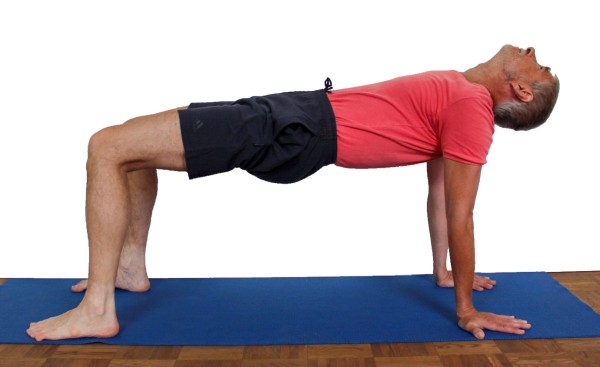
Instructions
- Set up as for variation 1a, but turn the hands backwards so that the forearms are in supination.
Details
- The difference that the hands turned backwards, i.e. the supination of the forearms, makes has already been described in the details of variation 1b.
1a eka pada: legs bent (feet up), arms stretched, hands pointing forward, one leg raised
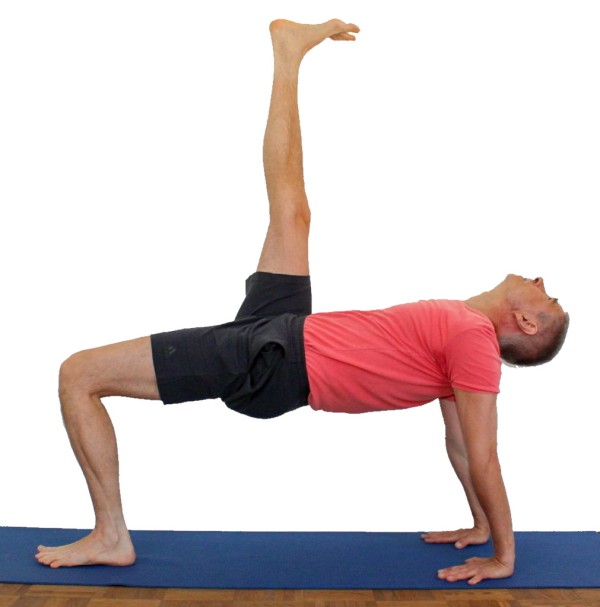
Effects: (712) Strengthening the hip flexors
Instructions
- Adopt variation 1a.
- Place the left heel a little to the right between the middle of the feet and then the left forefoot a little to the right.
- Build up more strength in your left leg, take the weight off your right foot completely, straighten your right leg close to the floor and slowly raise it in a wide arc towards your chest.
Details
- It is generally possible to do without the diagonal step described above, which places the left foot on the center line of the body, but the stability is then significantly lower. The diagonal step is easy to achieve if the heel is first lifted and placed inwards, then loaded again so that the forefoot can be lifted and then moved as well. The reverse procedure is noticeably more difficult.
- The aim when lifting the leg is to stretch it as far as possible towards the chest. First extend the leg close to the floor before lifting it. Depending on the flexibility of the hip flexors, the extended leg can even be briefly placed on the floor with minimal weight on the heel, whereby the maximum extension in the relevant hip joint is clearly recognizable. The pelvis remains raised as much as possible. At the end of the arc, the flexibility restrictions of the hamstrings will limit the movement and cause a clear bending tendency in the raised knee joint. Stretch it with quadriceps strength. This can lead to a tendency to spasm in the rectus femoris, as it is involved in both movements(extension of the knee joint and flexion in the hip joint) and has a very short sarcomere length and is therefore close to active insufficiency. If there is a tendency to cramp, it is important to consider whether the last degrees of extension of the knee joint or the last degrees of flexion in the hip joint should be avoided in order to prevent the cramp.
- As in similar asymmetrical postures, e.g. eka pada setu bandha sarvangasana or eka pada viparita dandasana, the pelvis rotates horizontally (in the frontal plane), as both the work of the pomus muscles and the hip flexors cause a tendency to exorotate and abduct in the hip joint of the standing leg. This rotation of the pelvis can lead to a slight tendency to spasm of the posterior-lateral back muscles. As far as possible, the affected flank must be stretched, i.e. the hip must be moved away from the equilateral shoulder. The knee of the supporting leg must move inwards, the supporting foot remains parallel to the center line of the body and the inner foot remains on the floor.
- Another evasive movement is caused by the asymmetry resulting from the gravitational force of the lifted leg on one side and the standing leg lifting the pelvis on the other side. This allows the hip of the lifted leg to hang lower than the other. This can be compensated for with hip muscles.
- In various conditions of the lower back, lifting the extended leg using the strength of the hip flexors can lead to discomfort in the lower back, which is not surprising due to the mass and the lever arm. After all, the leg is largely dependent on the iliopsoas, which tends to hyperlordose the lumbar spine.This discomfort should disappear as the flexion angle increases, and ultimately this variation should feel more comfortable in the lumbar spine than the one with both legs on the floor. If the leg exceeds the vertical, its gravity even drives the hip of the standing leg out of hyperlordosis and promotes the desirable extension in the hip joint in question.
1b eka pada: legs bent (feet up), arms stretched, hands pointing backwards, one leg raised
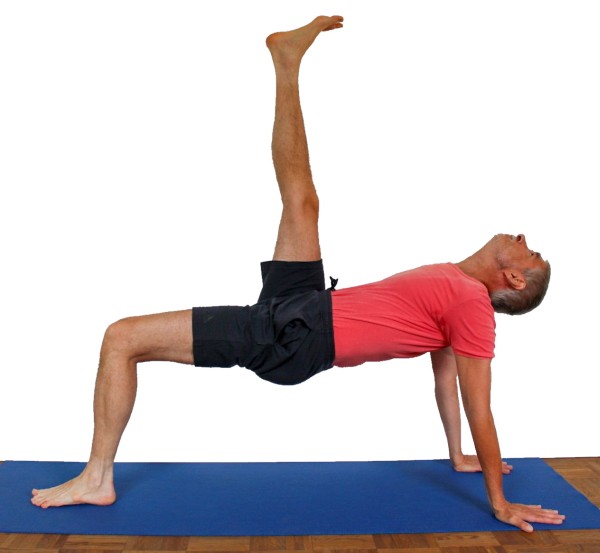
Effects: (712) Strengthening the hip flexors
Instructions
- Set up as for variation 1a eka pada, but turn the hands back so that the forearms are in supination.
Details
- The difference that the hands turned backwards, i.e. supination of the forearms, makes has already been described in the details of variation 1b.
2a: Legs stretched, arms stretched, hands pointing forwards
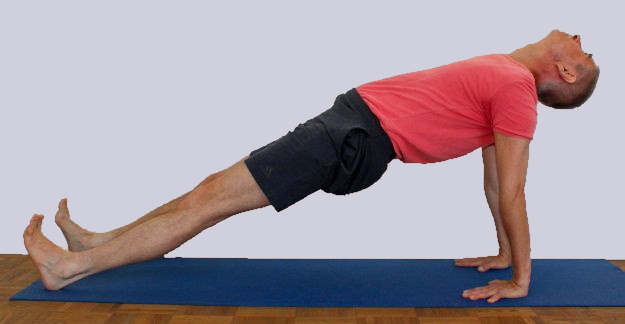
Instructions
- Sit in dandasana.
- Place the hands facing forward approx. 30 cm behind the pelvis, stretch the legs with the strength of the quadriceps.
- Raise the pelvis slightly to stretch the arms.
- Raise the pelvis to the maximum and tilt the hips into maximum extension.
- Allow the head to sink into maximum reclination.
Details
- This version differs from the bent leg version in several ways. The extended legs significantly lengthen the lever arm on which the extensors of the hip joint(hamstrings and pomus muscles) lift the pelvis, which means that this movement is more strenuous and more restricted. At the same time, however, there is no tendency to cramp in the hamstrings, as this musculature contracts far less and thus is in much greater sarcomer length far from active insufficiency.
- Several evasive movements occur: the work of the pomus muscles and the tensed hip flexors create a clear exorotationtendency of the thighs in the hip joints, which must be compensated for, and the work of the hamstrings as hip extensors, which lift the pelvis, creates a flexion tendencyin the knee joint, against which the quadriceps must work. Furthermore, the feet are pushed into plantar flexion, i.e. the forefoot tilts forwards or downwards. This is probably to be understood as a relief reaction of the biarticular gastrocnemius so that it does not pull the knee joint into flexion in addition to the hamstrings. The foot lifts must be used to counteract this so that the foot and the whole leg return to and maintain the tadasana posture.
- Compared to the variations with the foot raised, the arms are in less retroversion, which relieves the strain on some stretches, especially those of the anterior deltoid, biceps and pectoralis major. If the lifting of the upper body and therefore also the pelvis was significantly restricted by these muscles, it should be easier here, but if the strength of the hip extensors or the restricted flexibility of the hip flexors was the limiting factor, it is the other way round.
- Here it is even more important than in the variants with feet upright to pay attention to the correct distance, which should be measured so that the arms are vertical. If the hands were too close to the feet, the gravity of the upper body and head would pull the body away from the feet and unintentionally reduce the stretch in the direction of the retroversion.
2b: Legs stretched, arms stretched, hands pointing backwards
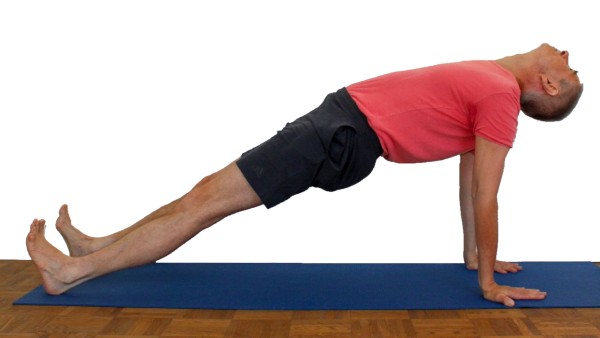
Instructions
- Set up as for variation 2a, but turn your hands backwards so that your forearms are in supination.
Details
- The difference that the hands turned backwards, i.e. supination of the forearms, makes has already been described in the details of variation 1b.
2a eka pada: legs stretched, arms stretched, hands pointing forward, one leg raised
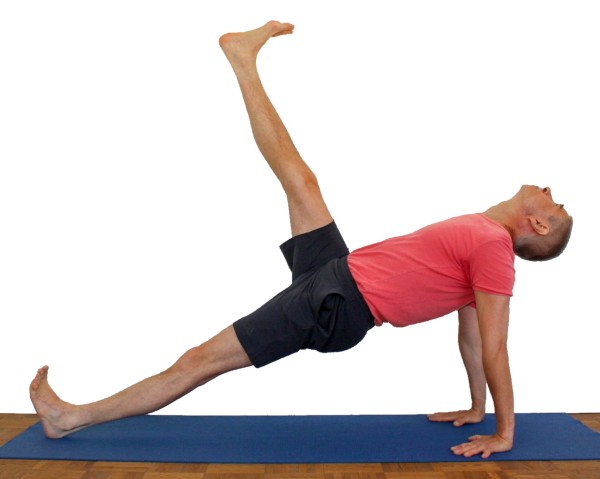
Effects: (712) Strengthening the hip flexors
Instructions
- Adopt variation 2a described above.
- As in variation 1a e ka pada, place the left foot slightly to the right in the center of the body.
- As in 1a eka pada, straighten the leg close to the floor and then slowly move it as far as possible towards the chest.
Details
- The details are the same as in variations 1a eka pada and 2a.
- As the pelvis has to be lifted against the additional gravity of the lifted leg with the leg extended and therefore with a poor lever arm, not only is far more strength required, but the inclination of the standing leg to turn out and bend is also greater.
2b eka pada: legs stretched, arms stretched, hands pointing backwards, one leg raised
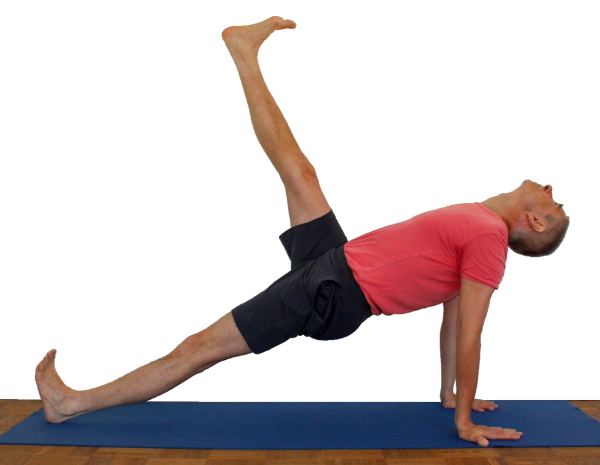
Effects: (712) Strengthening the hip flexors
Instructions
- Set up as for variation 2a eka pada, but turn the hands back so that the forearms are in supination.
Details
- The difference that the hands turned backwards, i.e. supination of the forearms, makes has already been described in the details of variation 1b.
3: Legs bent (feet planted), arms bent (forearms planted)
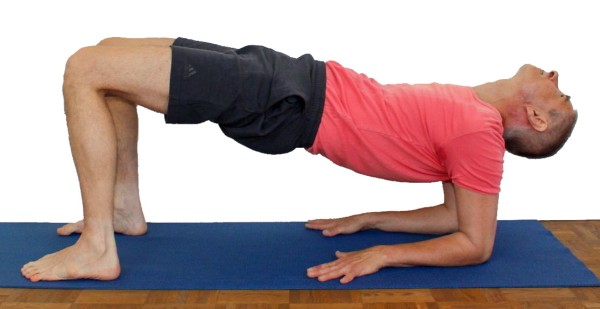
Instructions
- Sit in dandasana, place your legs at a 90° angle, the midlines of your feet parallel, your feet hip-width apart.
- Place the fingers at the height of the buttocks and lean backwards to place the forearms parallel to the floor, pointing forwards.
- Raise the pelvis to the maximum and tilt the hips into maximum extension.
- Allow the head to sink into reclination as far as possible.
Details
- The flexibility of the shoulders becomes even more important when the forearms are positioned, as the knees are higher than the shoulders. The upper body can now be lifted less easily than in the previous variations. Often, it is no longer the extension abilityin the hips that is the limiting factor when lifting the pelvis, but rather the restriction of retroversion of the arms acting via the upper body to the pelvis.
- The forearms rotate slightly out of pronation so that the inner wrists and inner hands come off the floor. Push them down as hard as possible! The hands may slide a little towards each other, try to avoid this too.
- Partly due to the tension on the pectoralis major, the arms tend to lose their wide external rotation, which corresponds to the inward movement of the hands and forearms due to the weight on the elbows.
- This is probably the most intensive variant for stretching the deltoids .
3 eka pada: legs bent (feet planted), arms bent (forearms planted), one leg raised
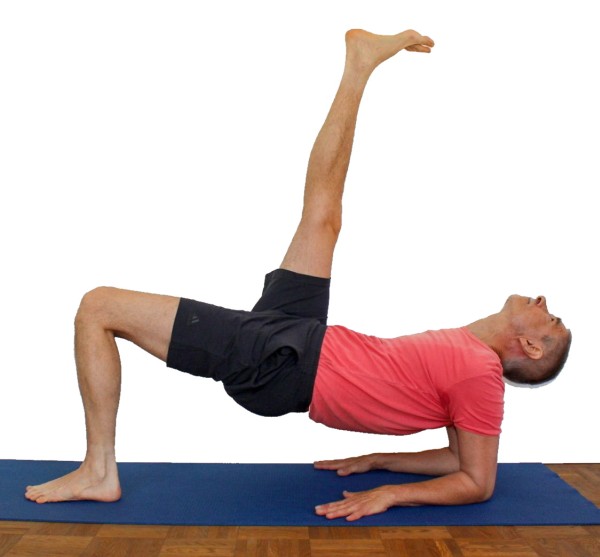
Effects: (712) Strengthening the hip flexors
Instructions
- Take variation 3.
- Similar to variation 1a eka pada, extend the leg close to the floor and then slowly stretch it as far as possible towards the chest.
Details
- ..
4: Legs stretched, arms bent (forearms raised)
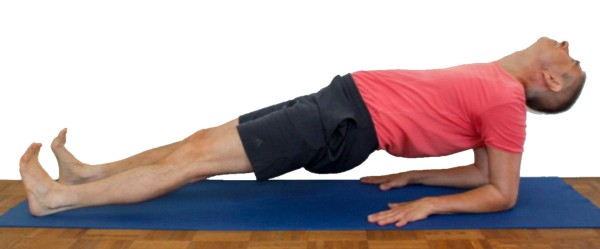
Instructions
- Sit in dandasana.
- Lean back slightly to place the forearms parallel to the floor pointing forwards, straighten the legs with the strength of the quadriceps.
- Raise the pelvis to the maximum and tilt it fully into extension.
- Let your head sink into reclination as far as possible.
Details
- The variations with the legs stretched out and the forearms raised are the most interesting and most difficult of the purvottanasana variations: the lever arm to lift the pelvis using the strength of the hip extensors is very large, which is why a lot of force has to be exerted and at the same time the flexibility restrictions of the shoulder joint from above work against the lifting of the upper body and pelvis.
- Depending on flexibility and power, it may not be possible to lift the pelvis off the floor.
4 eka pada: legs stretched, arms bent (forearms resting on the floor), one leg raised
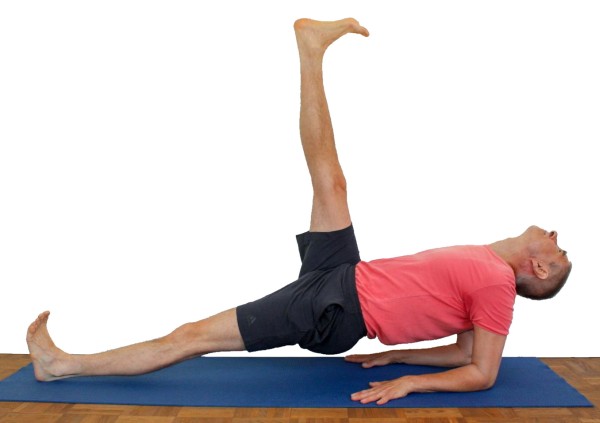
Effects: (712) Strengthening the hip flexors
Instructions
- Perform variation 4 as described above.
- Similar to variation 1a eka pada, slowly raise the leg as far as possible towards the chest.
Details
- This variation is clearly the most intense and challenging of all the purvottanasana variations.
Belt around the thighs
Only for variations with feet on the floor: this prevents the knees from moving out of alignment
Instructions
- Take the pose as described above but with a belt around the thighs close to the knees so that they do not fall further apart than hip width.
Details
- In contrast to setu bandha sarvangasana with a belt, which is quite similar to setu bandha sarvangasana with a belt, there is less discomfort in the outer knee.
- The thighs often twist outwards, which will also occur less with the use of the belt.
Wrists on patches
Instructions
- adopt the posture as described above, but place the wrists (the carpus) on patches to reduce the demand on the dorsiflexion in the wrist.
Details
- This variation is an analogy to the upface dog and similar postures with a requirement of about 90° in the wrists. It is used when the 90° angle cannot be realized, for example due to a ganglion or contractures of the finger flexors or the palmar flexors of the wrist, if at the same time moving the shoulder area only provides insufficient relief. The patches are then only positioned under the carpus, i.e. about two fingers wide on the wrist side under the hand.
- The same applies to the distance between the hands and feet as already mentioned in the basic posture: a smaller distance generally relieves discomfort in the wrist if the hands are pointing towards the feet. If they are pointing backwards, a greater distance helps.
Fixing the feet
Instructions
- Take the pose as described above, but use aids to ensure that the feet cannot turn out.
Details
- One way to fix the feet is to place them between shoulder plates that are held immobile by heavy dumbbells. To do this, place a shoulder support plate exactly between the feet and one each in the left and right outer foot area. Typically, a heavy dumbbell (e.g. 15 kg) placed on the middle and one of the outer shoulder plates is sufficient. Three shoulder plates and two heavy dumbbells are therefore required. Another option is to place a belt around the feet, which in turn stand right next to a shoulder stand plate. This variation uses less equipment, but is somewhat more difficult to set up.
(P) Stretching the raised leg
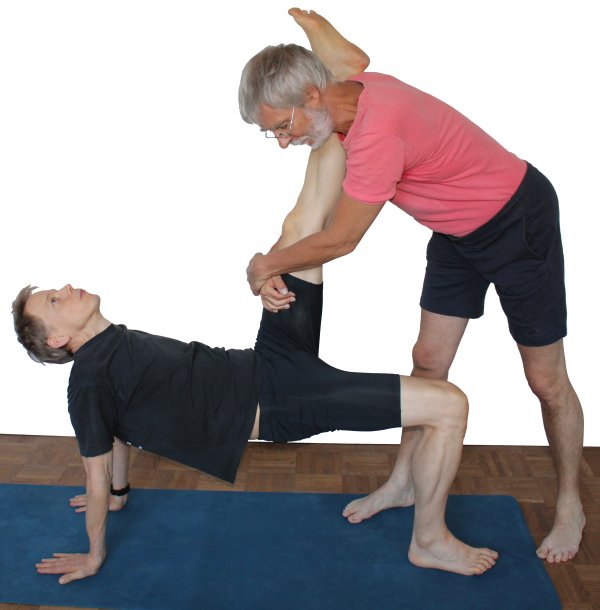
Instructions
- Adopt a desired eka pada variation as described above. The supporter stands next to the performer’s standing foot, places the performer’s Achilles tendon (of the lifted leg) on his shoulder and grasps the performer’s thigh with both hands approximately in the middle in order to pull it towards him and thus extend the knee joint of the lifted leg.
- If the knee joint of the lifted leg is extended and the intensity in the hamstrings of this leg is still rather low, the supporter can further flex the lifted leg in the hip joint by carefully bending towards the performer’s ribcage.
Details
- This support is similar to the eka pada variation of urdhva hastasana and the eka pada variation of setu bandha sarvangasana.
- The support must be released slowly and with a signal so that the rectus femoris in the lifted leg does not spasm.
(P) Lifting the pelvis with a belt
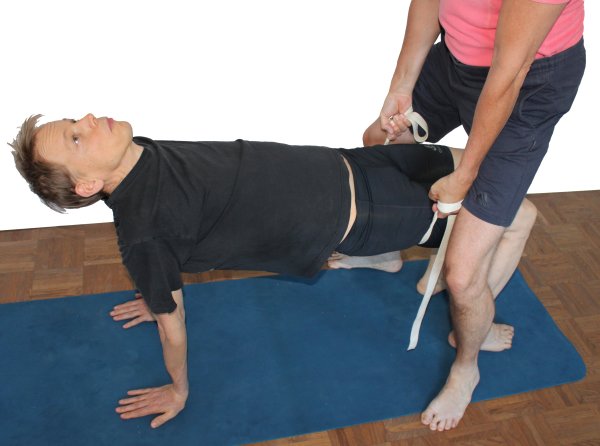
Instructions
- Take the pose as described above
- The supporter places a belt around both buttocks and pulls the pelvis away from the floor with increasing force on this belt.
Details
- The belt must not be placed in the lumbar spine, as is often the case, as this pulls the hip joints out of extension and increases any hyperlordosis that may be present, which can easily lead to discomfort in the region. If, on the other hand, it is placed in the buttock fold, the traction promotes the desired extension.
- Here too, it is important to slowly reduce the support so that the autochthonous muscles of the lumbar spine do not tense up reflexively.
(P) Raise the back between the shoulder blades
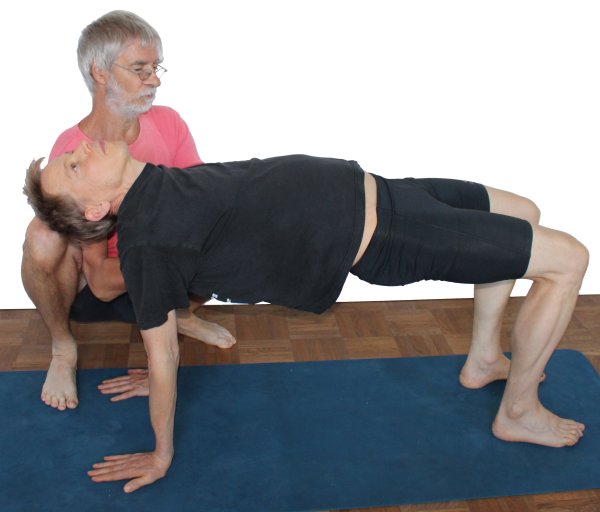
Instructions
- Squat next to the performer and lift the spine in the area between the shoulder blades with the flat of your hand
Details
- The shoulder blades should be in depression and retraction in these poses. The latter is encouraged when the upper body is lifted between the arms. Protraction of the shoulder blade would be contraindicated, particularly if the shoulder joint is known to be unstable and prone to dislocation.
(P) Keep the knees together
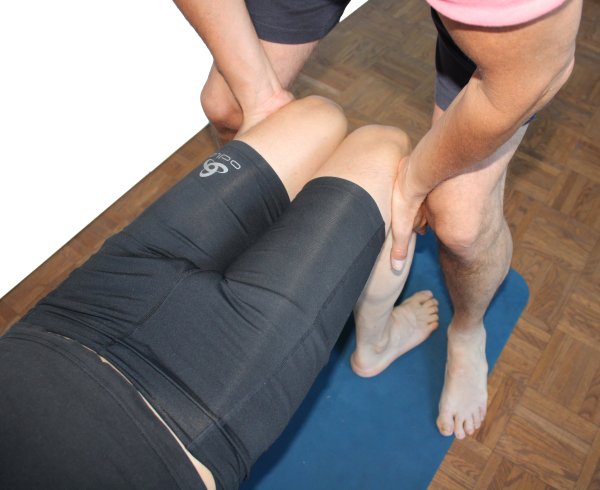
Instructions
- take the pose as described. The supporter stands with both legs slightly straddled next to the performer’s knees to limit their outward movement.
Details
- The supporter does not press against the outside of the performer’s thighs with his medial femoral condyles, but with the area of the adductors near his femoral condyles. The areas on which pressure is exerted are not the lateral condyles, but the thighs close to them.
- As with other supports, it is important not to withdraw the support abruptly but slowly.
(P) Correct foot posture
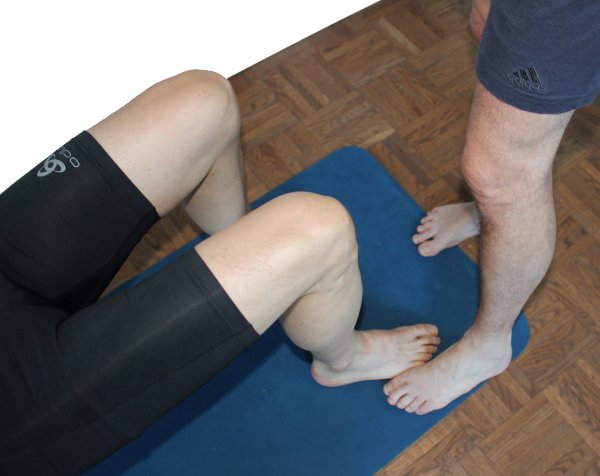
Corrects the plantar flexion of the feet and the exorotation of the thighs in variations with extended legs
Instructions
- Perform one of the variations with straight legs as described above.
- The supporter stands in front of the feet – or with one leg raised – and uses one foot to turn the foot or feet of the performer that remain on the floor back into the position in which the midlines of the feet are pointing vertically upwards. He then pushes the balls of the performer’s feet so far cranially with the balls of his feet that the performer’s ankle is again without plantar flexion.
Details
- This support can be performed comfortably without bending down.
